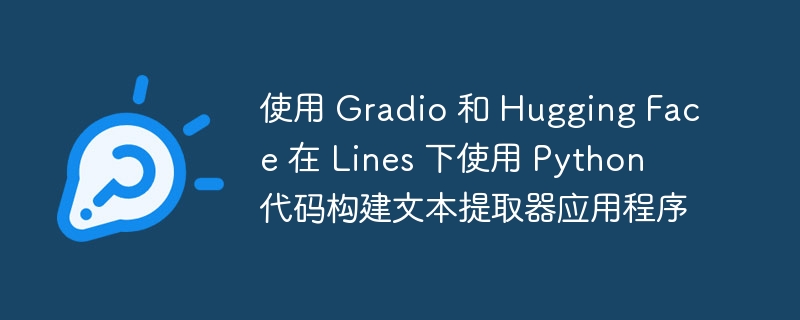使用 Gradio 和 Hugging Face 在 Lines 下使用 Python 代码构建文本提取器应用程序
来源:dev.to
时间:2024-11-07 09:54:59 488浏览 收藏
各位小伙伴们,大家好呀!看看今天我又给各位带来了什么文章?本文标题是《使用 Gradio 和 Hugging Face 在 Lines 下使用 Python 代码构建文本提取器应用程序》,很明显是关于文章的文章哈哈哈,其中内容主要会涉及到等等,如果能帮到你,觉得很不错的话,欢迎各位多多点评和分享!

原帖:https://baxin.netlify.app/build-text-extractor-python-under-30-lines/
从图像中提取文本,称为光学字符识别 (ocr),对于文档处理、数据提取和可访问性应用程序来说是一项很有价值的功能。在本指南中,我们将使用 python 库创建一个 ocr 应用程序,例如用于 ocr 的 pytesseract、用于图像处理的 pillow 以及用于构建交互式 ui 的 gradio。我们将在 hugging face spaces 上部署此应用程序。
先决条件
开始之前,您需要一个 hugging face 帐户并对 docker 有基本的了解。
分步指南
第 1 步:创建一个拥抱脸部空间
- 导航到 hugging face spaces:登录 hugging face 并转到“spaces”部分。
-
创建一个新空间:
- 点击“新空间”。
- 为您的空间命名(例如,图像文本提取器)。
- 选择gradio作为sdk并设置可见性(公共或私有)。
- 点击“创建空间”。
第 2 步:创建 dockerfile
要在具有所需系统依赖项的 hugging face spaces 上部署(例如用于 ocr 的 tesseract),我们需要一个用于配置环境的 dockerfile。
创建一个包含以下内容的 dockerfile:
# use an official python runtime as a parent image from python:3.12 env pip_root_user_action=ignore # set the working directory in the container workdir $home/app # install system dependencies run apt-get update && apt-get install -y run apt-get install -y tesseract-ocr run apt-get install -y libtesseract-dev run apt-get install -y libgl1-mesa-glx run apt-get install -y libglib2.0-0 run pip install --upgrade pip # copy requirements and install dependencies copy requirements.txt requirements.txt run pip install --no-cache-dir -r requirements.txt # copy the app code copy app.py ./ # expose the port for gradio expose 7860 # run the application cmd ["python", "app.py"]
第 3 步:创建 ocr 应用程序
- 创建一个名为 app.py 的文件,其中包含以下内容:
import gradio as gr
import pytesseract
from pil import image
import os
def extract_text(image_path):
if not image_path:
return "no image uploaded. please upload an image."
if not os.path.exists(image_path):
return f"error: file not found at {image_path}"
try:
img = image.open(image_path)
text = pytesseract.image_to_string(img)
return text if text.strip() else "no text detected in the image."
except exception as e:
return f"an error occurred: {str(e)}"
iface = gr.interface(
fn=extract_text,
inputs=gr.image(type="filepath", label="upload an image"),
outputs=gr.textbox(label="extracted text"),
title="image text extractor",
description="upload an image and extract text from it using ocr."
)
iface.launch(server_name="0.0.0.0", server_port=7860)
- 创建requirements.txt文件来指定依赖项:
gradio pytesseract Pillow
此设置包括:
- 图像上传:gr.image(type="filepath") 允许用户将图像作为文件路径上传,由 pytesseract 处理。
- 文本提取:pytesseract.image_to_string 从图像中提取文本。
- 用户界面:gradio 生成一个简单的 ui,供用户上传图像和查看提取的文本。
第 4 步:将所有文件推送到拥抱面部空间
创建所有文件后,将它们推送到您的拥抱空间
好了,本文到此结束,带大家了解了《使用 Gradio 和 Hugging Face 在 Lines 下使用 Python 代码构建文本提取器应用程序》,希望本文对你有所帮助!关注golang学习网公众号,给大家分享更多文章知识!
-
501 收藏
-
501 收藏
-
501 收藏
-
501 收藏
-
501 收藏
-
219 收藏
-
126 收藏
-
197 收藏
-
239 收藏
-
167 收藏
-
139 收藏
-
247 收藏
-
405 收藏
-
467 收藏
-
181 收藏
-
499 收藏
-
480 收藏
-

- 前端进阶之JavaScript设计模式
- 设计模式是开发人员在软件开发过程中面临一般问题时的解决方案,代表了最佳的实践。本课程的主打内容包括JS常见设计模式以及具体应用场景,打造一站式知识长龙服务,适合有JS基础的同学学习。
- 立即学习 543次学习
-

- GO语言核心编程课程
- 本课程采用真实案例,全面具体可落地,从理论到实践,一步一步将GO核心编程技术、编程思想、底层实现融会贯通,使学习者贴近时代脉搏,做IT互联网时代的弄潮儿。
- 立即学习 516次学习
-

- 简单聊聊mysql8与网络通信
- 如有问题加微信:Le-studyg;在课程中,我们将首先介绍MySQL8的新特性,包括性能优化、安全增强、新数据类型等,帮助学生快速熟悉MySQL8的最新功能。接着,我们将深入解析MySQL的网络通信机制,包括协议、连接管理、数据传输等,让
- 立即学习 500次学习
-

- JavaScript正则表达式基础与实战
- 在任何一门编程语言中,正则表达式,都是一项重要的知识,它提供了高效的字符串匹配与捕获机制,可以极大的简化程序设计。
- 立即学习 487次学习
-

- 从零制作响应式网站—Grid布局
- 本系列教程将展示从零制作一个假想的网络科技公司官网,分为导航,轮播,关于我们,成功案例,服务流程,团队介绍,数据部分,公司动态,底部信息等内容区块。网站整体采用CSSGrid布局,支持响应式,有流畅过渡和展现动画。
- 立即学习 485次学习
